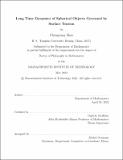Long Time Dynamics of Spherical Objects Governed by Surface Tension
Author(s)
Shao, Chengyang
DownloadThesis PDF (987.3Kb)
Advisor
Staffilani, Gigliola
Terms of use
Metadata
Show full item recordAbstract
This thesis is devoted to the study of evolutionary partial differential equations describing the motion of spherical objects in two different physical scenarios. They share the common feature of involving the mean curvature operator, hence relating to motions governed by surface tension. The mean curvature operator makes both problems highly nonlinear.
In the first part of this thesis, we study the long time behavior of an idealistic model of elastic membrane driven by surface tension and inner air pressure. The system is a degenerate quasilinear hyperbolic one that involves the mean curvature, and also includes a damping term that models the dissipative nature of genuine physical systems. With the presence of damping, a small perturbation of the sphere converges exponentially in time to the sphere, and without the damping the evolution that is 𝜀-close to the sphere has life span longer than 𝜀 [superscript -1/6]. Both results are proved using a new Nash-Moser-Hörmander type theorem proved by Baldi and Haus. The first part of the thesis grows out of the author’s research paper [58].
In the second part of this thesis, we derive a differential equation that describes the nonlinear vibration of a spherical water droplet under zero gravity. The equation is legitimately referred as the capillary spherical water waves equation. We develop a toolbox for paradifferential calculus on curved manifolds and prove the local existence for this equation by para-linearizing the equation. This approach avoids using Nash-Moser type iterations, and sets the stage for further study of longer time behavior of spherical water waves. For the longer time behavior, we discuss the resonance problem related to this equation, pointing out that it is a highly nontrivial problem of Diophantine analysis in the realm of number theory.
Date issued
2022-05Department
Massachusetts Institute of Technology. Department of MathematicsPublisher
Massachusetts Institute of Technology